Frictional Pressure Drop for Gas–Liquid Two-Phase Flow in Coiled Tubing
Abstract
:1. Introduction
2. CFD Modeling for Gas–Liquid Two-Phase Flow
2.1. Governing Equations
2.2. Geometric Configurations and Computational Conditions
3. Results and Discussion
3.1. Mesh Sensitivity Study
3.2. Model Validation between Simulations and Experiments
3.3. Effect of Gas Void Fraction on Frictional Pressure Losses
3.4. Effect of Curvature Ratio on Frictional Pressure Losses
3.5. Effect of Inlet Velocity on Frictional Pressure Losses
3.6. Development of Friction Factor Correlation for Gas–Liquid Two-Phase Flow in CT
4. Conclusions
Author Contributions
Funding
Conflicts of Interest
Nomenclature
| α | volume fraction, dimensionless |
| Re | Reynolds number, dimensionless |
| v | fluid velocity (m/s) |
| ρ | density of fluid (kg/m3) |
| μ | fluid viscosity (Pa·s) |
| f | friction factor, dimensionless |
| V | volumetric flow rate (m3/s) |
| g | acceleration of gravity (m/s2) |
| d | inside diameter of helical tubing (m) |
| D | diameter of coiled tubing reel (m) |
| Dn | Dean number, dimensionless |
| P | flow pressure (Pa) |
| N | number of tubing layers |
| LN | length of the Nth layer tubing |
| Lr | width of the reel |
| correction factor, dimensionless | |
| dP/dZ | pressure gradient |
| l | liquid phase |
| g | gas phase |
| tp | two-phase fluid |
| f | frictional pressure |
| c | critical value |
References
- Walton, I.C.; Gu, H. Hydraulics Design in Coiled Tubing Drilling. In Proceedings of the SPE Gulf Coast Section/ICoTA North American Coiled Tubing Roundtable, Conroe, TX, USA, 26–28 February 1996. [Google Scholar]
- McCann, R.C.; Isias, C.G. Frictional Pressure Loss during Turbulent Flow in Coiled Tubing. In Proceedings of the SPE Gulf Coast Section/ICoTA North American Coiled Tubing Roundtable, Conroe, TX, USA, 26–28 February 1996. [Google Scholar]
- Azouz, I.; Shah, S.N.; Vinod, P.S.; Lord, D.L. Experimental Investigation of Frictional Pressure Losses in Coiled Tubing. SPE Prod. Facil. 1998, 13, 91–96. [Google Scholar] [CrossRef]
- Rao, B.N. Friction Factors for Turbulent Flow of Non–Newtonian Fluids in Coiled Tubing. In Proceedings of the SPE/ICoTA Coiled Tubing Conference and Exhibition, Houston, TX, USA, 9–10 April 2002. [Google Scholar]
- Medjani, B.; Shah, S.N. A New Approach for Predicting Frictional Pressure Losses of Non–Newtonian Fluids in Coiled Tubing. In Proceedings of the Rocky Mountain Regional/Low–Permeability Reservoirs Symposium and Exhibition, Denver, Colorado, 12–15 March 2000. [Google Scholar]
- Willingham, J.D.; Shah, S.N. Friction Pressures of Newtonian and Non–Newtonian Fluids in Straight and Reeled Coiled Tubing. In Proceedings of the SPE/ICoTA Coiled Tubing Roundtable, Houston, TX, USA, 5–6 April 2000. [Google Scholar]
- Shah, S.N.; Zhou, Y. An Experimental Study of the Effects of Drilling Solids on Frictional Pressure Losses in Coiled Tubing. In Proceedings of the SPE Production and Operations Symposium, Oklahoma City, Oklahoma, 24–27 March 2001. [Google Scholar]
- Zhou, Y.; Shah, S.N. New Friction Factor Correlations for Non–Newtonian Fluid Flow in Coiled Tubing. SPE Drill. Completion. 2006, 21, 68–76. [Google Scholar] [CrossRef]
- Hou, X.; Zheng, H.; Zhao, J.; Chen, X. Analysis of Circulating System Frictional Pressure Loss in Microhole Drilling with Coiled Tubing. Open Pet. Eng. J. 2014, 7, 22–28. [Google Scholar] [CrossRef] [Green Version]
- Jain, S.; Singhal, N.; Shah, S.N. Effect of Coiled Tubing Curvature on Friction Pressure Loss of Newtonian and Non–Newtonian Fluids–Experimental and Simulation Study. In Proceedings of the SPE Annual Technical Conference and Exhibition, Houston, TX, USA, 26–29 September 2004. [Google Scholar]
- Zhou, Y.; Shah, S.N. Non–Newtonian Fluid Flow in Coiled Tubing: Theoretical Analysis and Experimental Verification. In Proceedings of the SPE Annual Technical Conference and Exhibition, San Antonio, TX, USA, 29 September–2 October 2002. [Google Scholar]
- Shah, S.; Zhou, Y.; Bailey, M.; Hernandez, J. Correlations to Predict Frictional Pressure Loss of Hydraulic–Fracturing Slurry in Coiled Tubing. SPE Prod. Oper. 2009, 24, 381–395. [Google Scholar] [CrossRef]
- Pereira, C.E.G.; da Cruz, G.A.; Pereira Filho, L.; Justino, L.R.; Paraiso, E.C.H.; Rocha, J.M.; Calçada, L.A.; Scheid, C.M. Experimental Analysis of Pressure Drop in the Flow of Newtonian Fluid in Coiled Tubing. J. Pet. Sci. Eng. 2019, 179, 565–573. [Google Scholar] [CrossRef]
- Oliveira, B.R.; Leal, B.C.; Pereira Filho, L.; Borges, R.F.d.O.; Paraíso, E.d.C.H.; Magalhães, S.d.C.; Rocha, J.M.; Calçada, L.A.; Scheid, C.M. A Model to Calculate the Pressure Loss of Newtonian and Non–Newtonian Fluids Flow in Coiled Tubing Operations. J. Pet. Sci. Eng. 2021, 204, 10864. [Google Scholar] [CrossRef]
- Martinelli, R.C.; Nelson, D.B. Prediction of Pressure Drop during Forced–Circulation of Boiling Water. Trans. ASME 1948, 70, 695–702. [Google Scholar]
- Lockhart, R.W.; Martinelli, R.C. Proposed Correlation of Data for Isothermal Two–Phase Two Component Flow in Pipes. Chem. Eng. Prog. 1949, 45, 39–45. [Google Scholar]
- Akagawa, K.; Sakaguchi, T.; Ueda, M. Study on a Gas– Liquid Two– Phase Flow in Helically Coiled Tubes. Bull. JSME 1971, 14, 564–571. [Google Scholar] [CrossRef] [Green Version]
- Bi, Q.; Chen, T.; Luo, Y.; Zheng, J.; Jing, J. Frictional Pressure Drop of Steam–Water Two–Phase Flow in Helical Coils with Small Helix Diameter of HTR–10. Chin. J. Nucl. Sci. Eng. 1996, 3, 208–213. [Google Scholar] [CrossRef]
- Xin, R.C.; Awwad, A.; Dong, Z.F.; Ebadian, M.A. An Experimental Study of Single–Phase and Two–Phase Flow Pressure Drop in Annular Helicoidal Pipes. Int. J. Heat Fluid Flow 1997, 18, 482–488. [Google Scholar] [CrossRef]
- Santini, L.; Cioncolini, A.; Lombardi, C.; Ricotti, M. Two–Phase Pressure Drops in a Helically Coiled Steam Generator. Int. J. Heat Mass Tran. 2008, 51, 4926–4939. [Google Scholar] [CrossRef]
- Guo, L.; Feng, Z.; Chen, X. An Experimental Investigation of the Frictional Pressure Drop of Steam–Water Two–Phase Flow in Helical Coils. Int. J. Heat Mass Tran. 2001, 44, 2601–2610. [Google Scholar] [CrossRef]
- Colombo, M.; Cammi, A.; Guédon, G.R.; Inzoli, F.; Ricotti, M.E. CFD Study of an Air–Water Flow inside Helically Coiled Pipes. Prog. Nucl. Energy 2015, 85, 462–472. [Google Scholar] [CrossRef] [Green Version]
- Cioncolini, A.; Santini, L. Two–Phase Pressure Drop Prediction in Helically Coiled Steam Generators for Nuclear Power Applications. Int. J. Heat Mass Tran. 2016, 100, 825–834. [Google Scholar] [CrossRef] [Green Version]
- Hardik, B.K.; Prabhu, S.V. Boiling Pressure Drop and Local Heat Transfer Distribution of Helical Coils with Water at Low Pressure. Int. J. Therm. Sci. 2017, 114, 44–63. [Google Scholar] [CrossRef]
- Zhao, H.; Li, X.; Wu, X. New Friction Factor Equations Developed for Turbulent Flows in Rough Helical Tubes. Int. J. Heat Mass Tran. 2016, 95, 525–534. [Google Scholar] [CrossRef]
- Xiao, Y.; Hu, Z.; Chen, S.; Gu, H. Experimental Study of Two–Phase Frictional Pressure Drop of Steam–Water in Helically Coiled Tubes with Small Coil Diameters at High Pressure. Appl. Therm. Eng. 2018, 132, 18–29. [Google Scholar] [CrossRef]
- Wu, J.; Li, X.; Liu, H.; Zhao, K.; Liu, S. Calculation Method of Gas–Liquid Two–Phase Boiling Heat Transfer in Helically–Coiled Tube Based on Separated Phase Flow Model. Int. J. Heat Mass Tran. 2020, 161, 114381. [Google Scholar] [CrossRef]
- Wu, J.; Li, Z.; Li, S.; Chen, Y.; Liu, S.; Xia, C.; Chen, Y. Numerical Simulation Research on Two–Phase Flow Boiling Heat Transfer in Helically Coiled Tube. Nucl. Eng. Des. 2022, 395, 111827. [Google Scholar] [CrossRef]
- Gidaspow, D. Multiphase Flow and Fluidization: Continuum and Kinetic Theory Descriptions; Academic Press: Cambridge, MA, USA, 2012. [Google Scholar]
- Rzasa, M.R.; Czapla–Nielacna, B. Analysis of the Influence of the Vortex Shedder Shape on the Metrological Properties of the Vortex Flow Meter. Sensors 2021, 21, 4697. [Google Scholar] [CrossRef] [PubMed]
- Wilcox, D.C. Turbulence Modeling for CFD; DCW Industries: La Canada, CA, USA, 1998. [Google Scholar]
- Zhou, Y.; Shah, S.N. Rheological Properties and Frictional Pressure Loss of Drilling, Completion, and Stimulation Fluids in Coiled Tubing. J. Fluid Eng.–T ASME 2004, 126, 153–161. [Google Scholar] [CrossRef]
- Zhou, Y. Theoretical and Experimental Studies of Power–Law Fluid Flow in Coiled Tubing; University of Oklahoma: Norman, Oklahoma, 2006. [Google Scholar]
- Fluent. Ansys Fluent User’s Guide; ANSYS, Inc. Release 19.0: Canonsburg, PA, USA, 2018. [Google Scholar]
- Ogugbue, C.C.; Shah, S.N. Laminar and Turbulent Friction Factors for Annular Flow of Drag–Reducing Polymer Solutions in Coiled–Tubing Operations. SPE Drill. Completion 2011, 26, 506–518. [Google Scholar] [CrossRef]
- Srinivasan, P.S.; Nandapurkar, S.S.; Holland, S.S. Friction Factors for Coils. Trans. Inst. Chem. Eng. 1970, 48, 156–161. [Google Scholar]
- Wongwises, S.; Polsongkram, M. Condensation Heat Transfer and Pressure Drop of HFC–134a in a Helically Coiled Concentric Tube–in–Tube Heat Exchanger. Int. J. Heat Mass Transf. 2006, 49, 4386–4398. [Google Scholar] [CrossRef]
- Chisholm, D. Two–Phase Flow in Pipelines and Heat Exchangers; Longmen Group Ltd.: London, UK, 1983. [Google Scholar]
- Bharath, R. Coiled Tubing Hydraulics Modeling; CTES, L. C: Conroe, TX, USA, 1999. [Google Scholar]
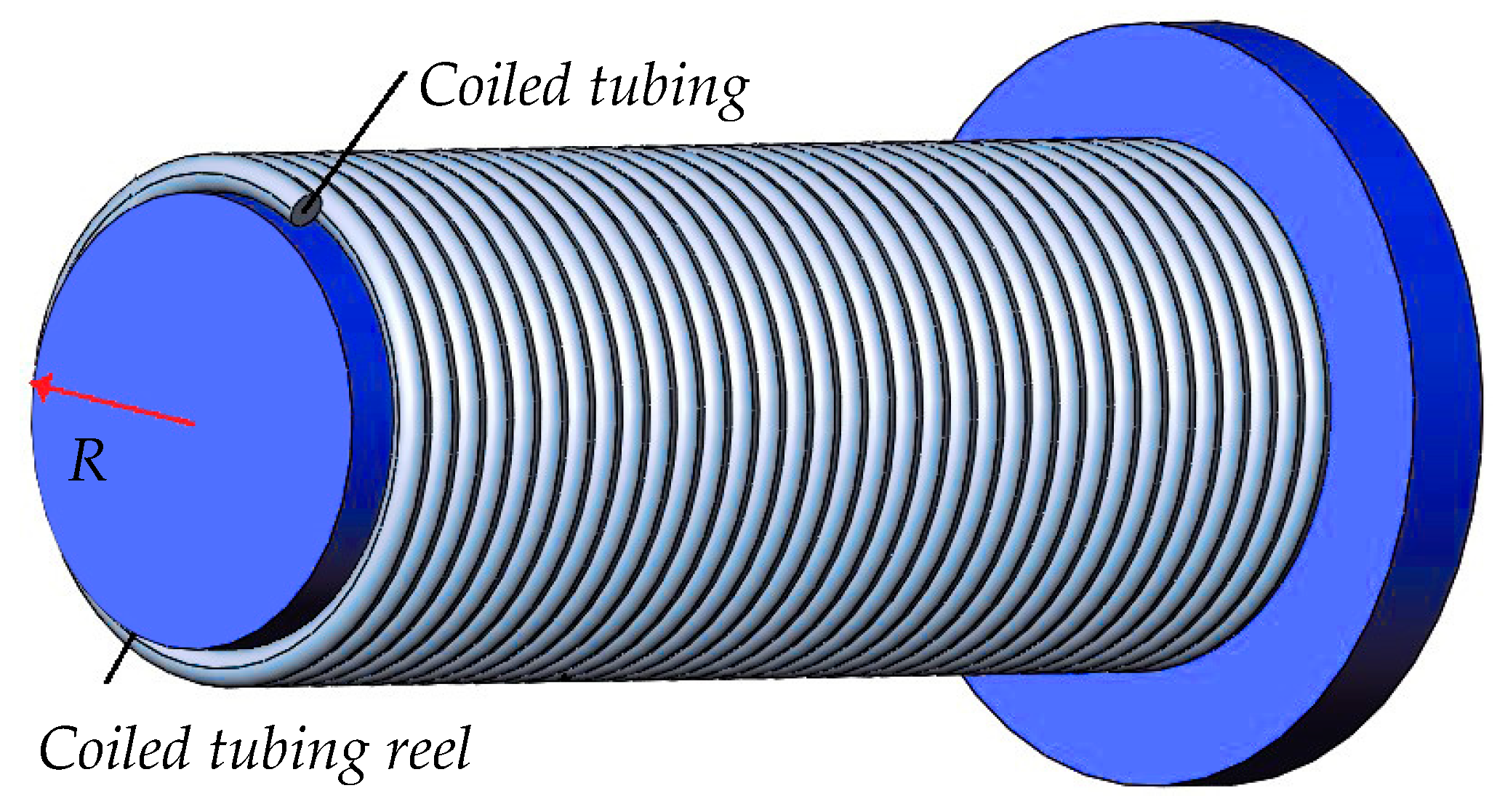
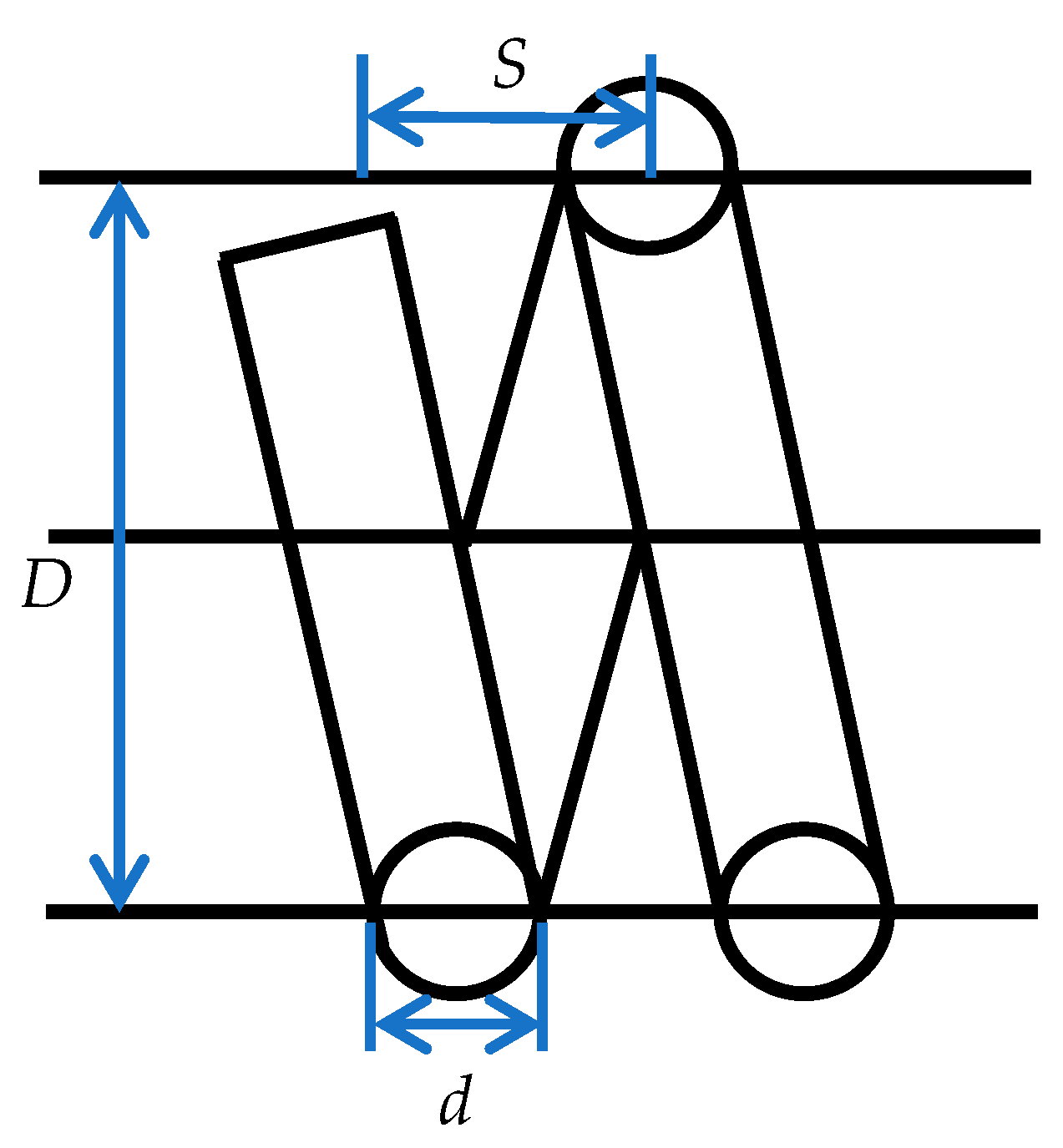


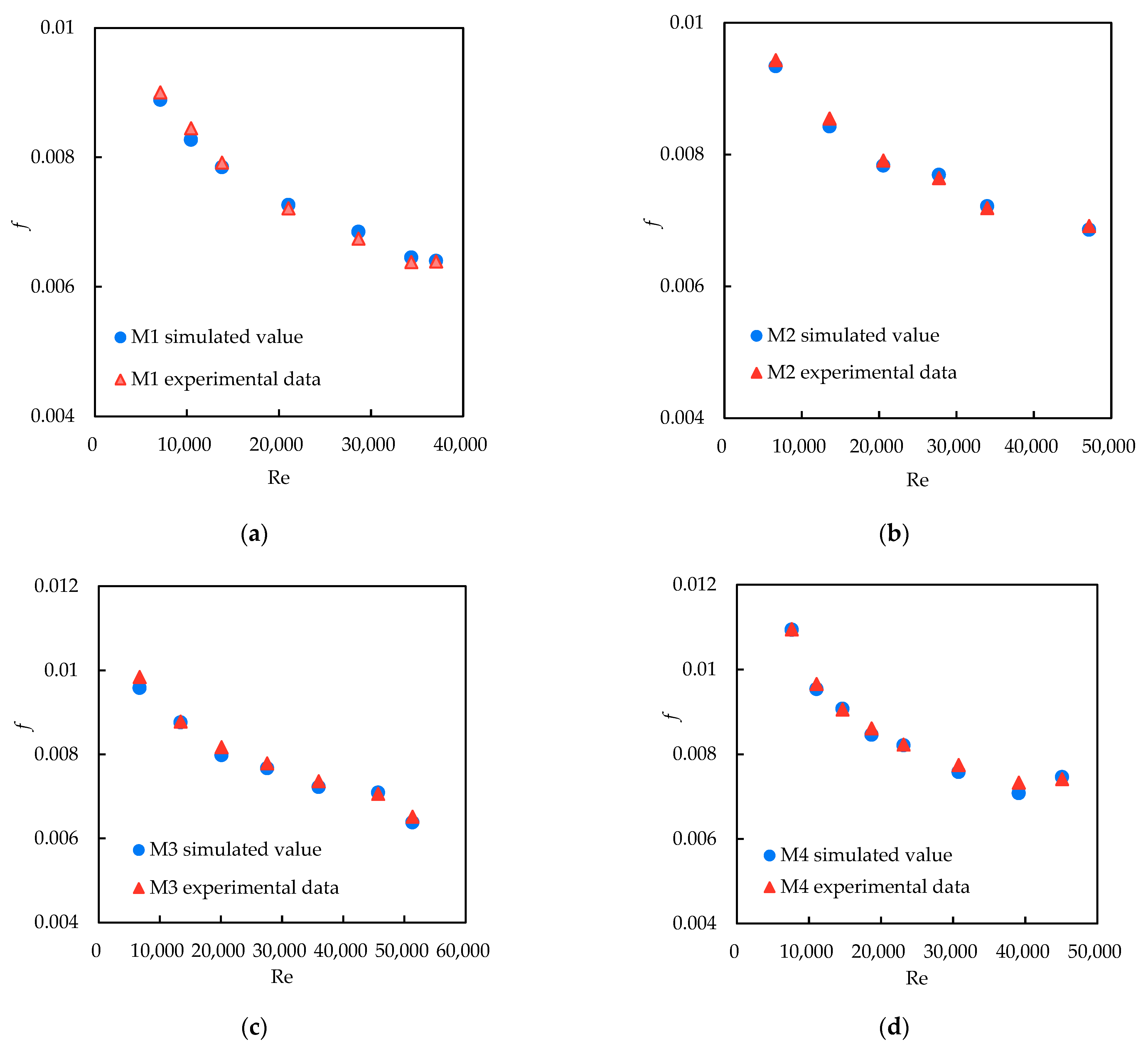


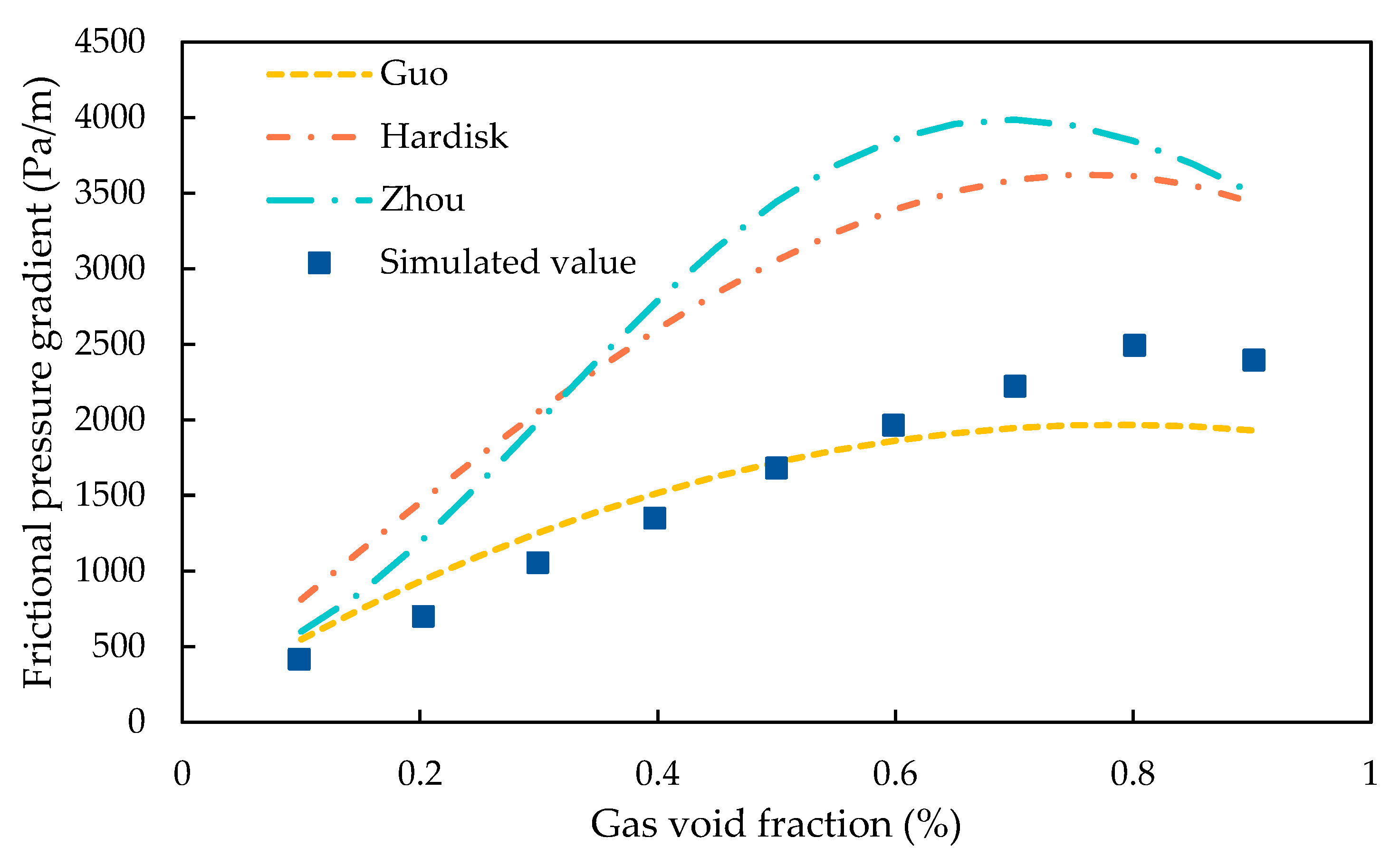

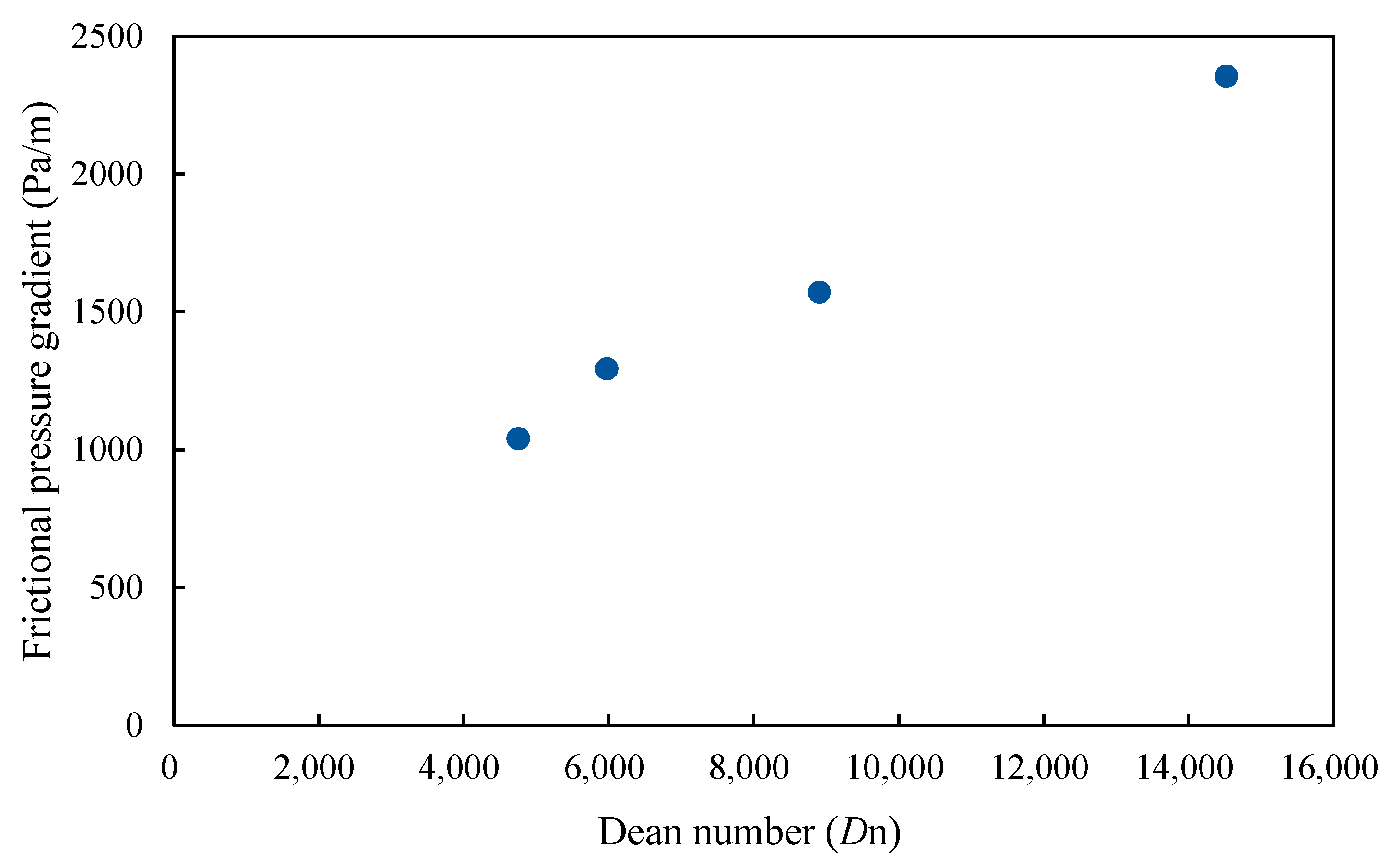
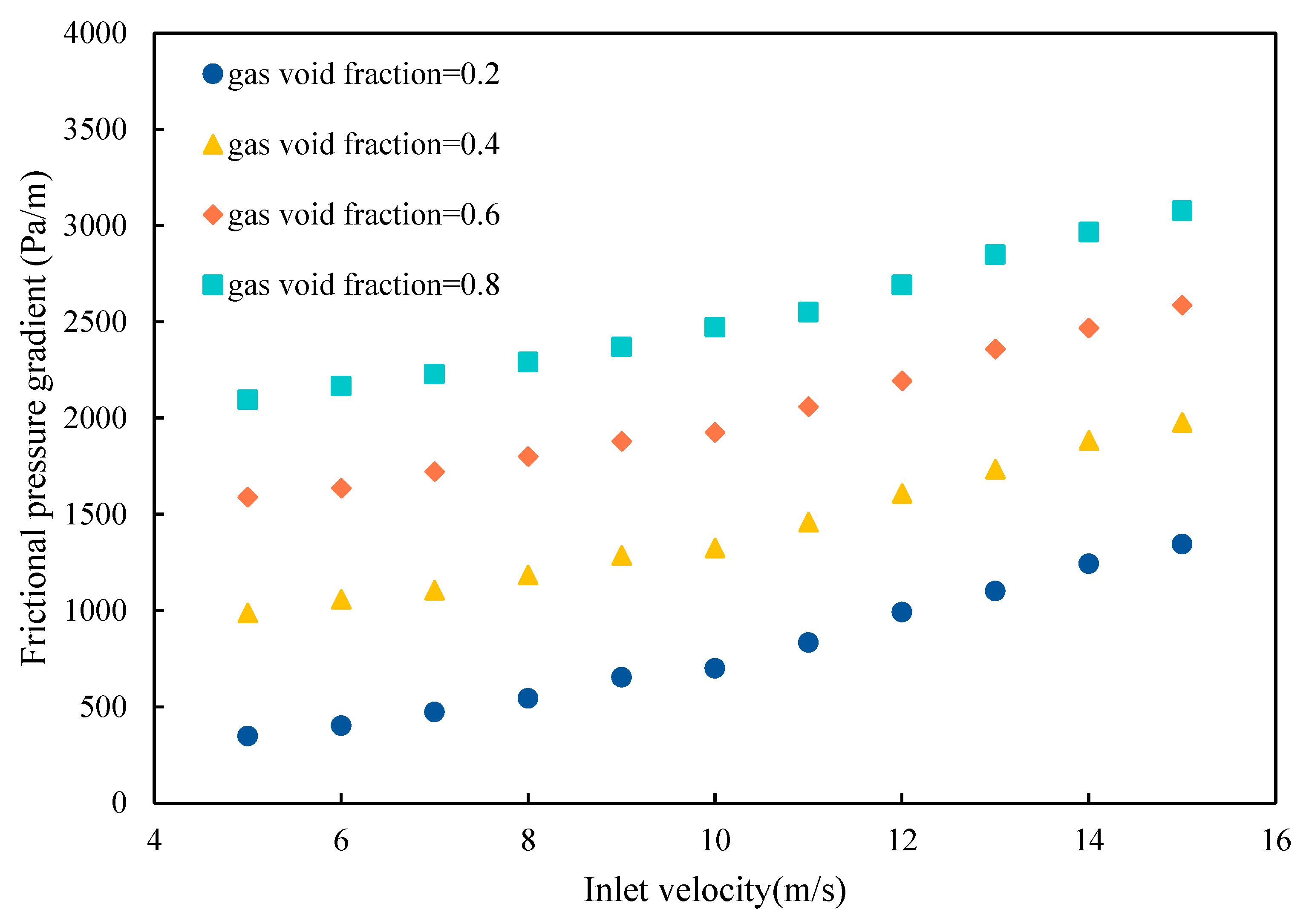
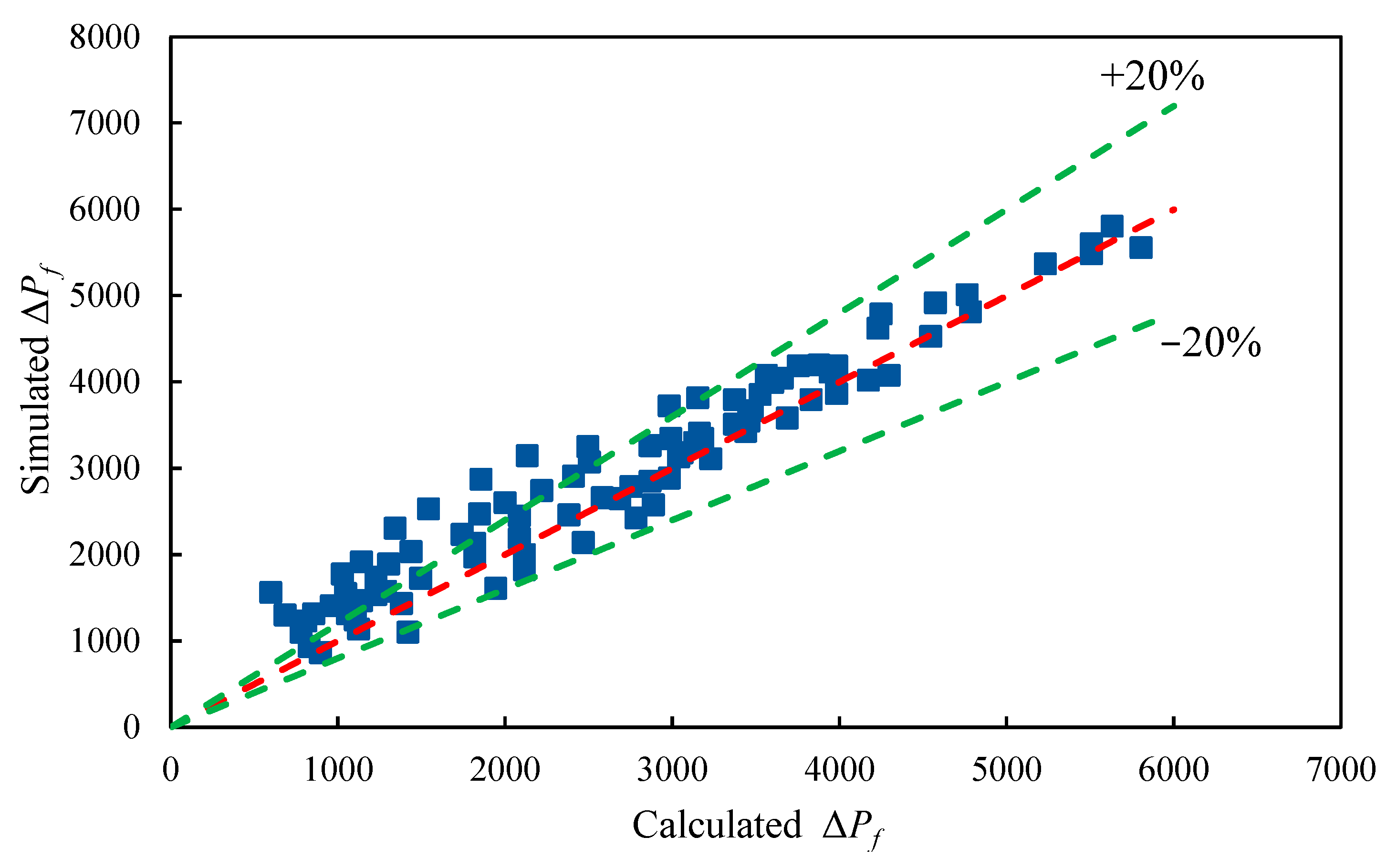
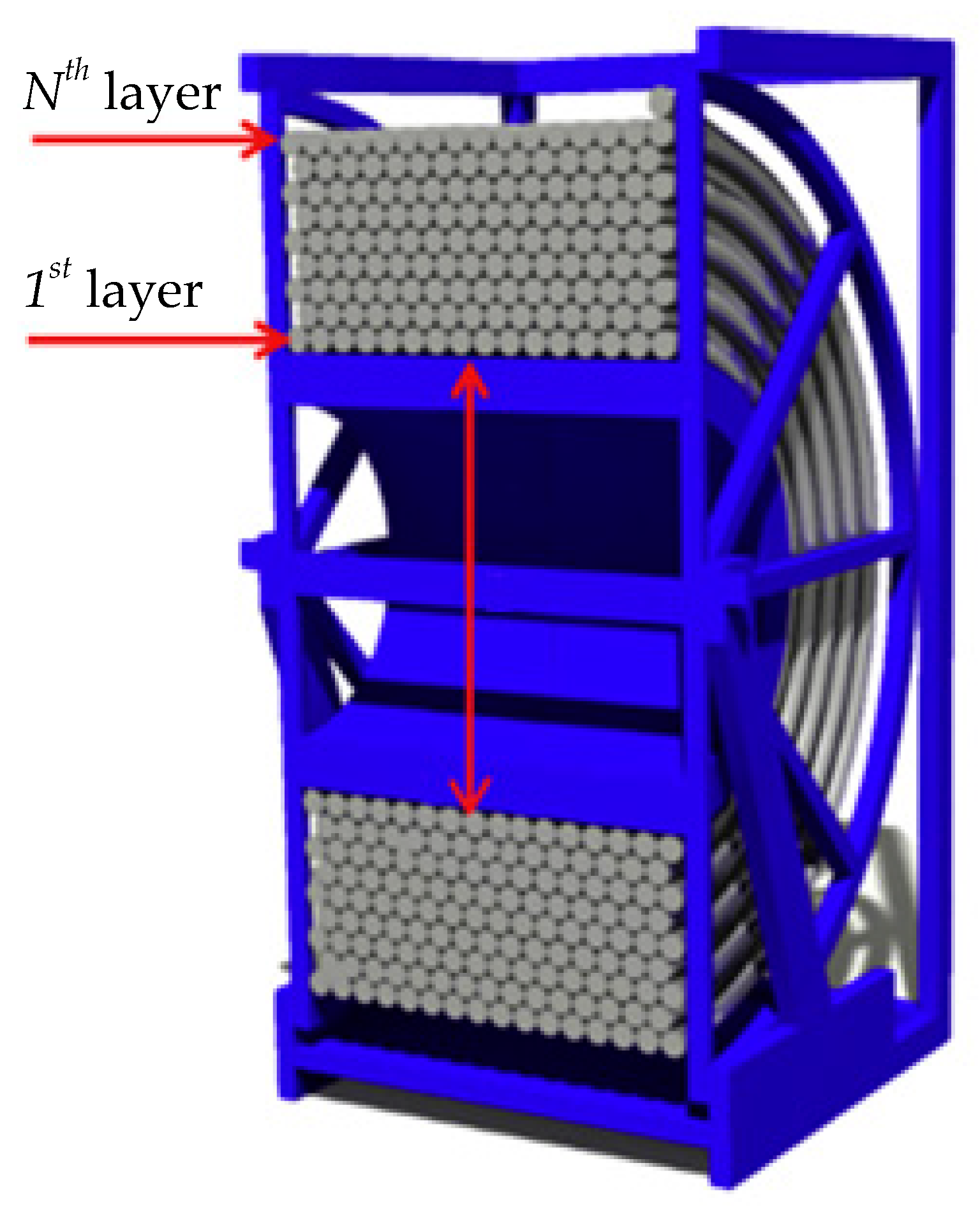
| Model | CT Diameter | Coil Diameters | Curvature Ratio |
|---|---|---|---|
| d (in) | D (in) | d/D | |
| M1 | 0.435 | 3.6 | 0.010 |
| M2 | 0.435 | 1.8 | 0.019 |
| M3 | 0.435 | 1.2 | 0.031 |
| M4 | 0.435 | 0.5 | 0.076 |
| M5 | 0.810 | 48 | 0.017 |
| M6 | 1.532 | 82 | 0.018 |
| Model | Avg. Error | RMS |
|---|---|---|
| M1 | 1.11% | 0.0029 |
| M2 | 0.88% | 0.0035 |
| M3 | 1.57% | 0.0053 |
| M4 | 1.21% | 0.0060 |
| M5 | 0.72% | 0.0027 |
| M6 | 1.43% | 0.0063 |
Publisher’s Note: MDPI stays neutral with regard to jurisdictional claims in published maps and institutional affiliations. |
© 2022 by the authors. Licensee MDPI, Basel, Switzerland. This article is an open access article distributed under the terms and conditions of the Creative Commons Attribution (CC BY) license (https://creativecommons.org/licenses/by/4.0/).
Share and Cite
Sun, S.; Liu, J.; Zhang, W.; Yi, T. Frictional Pressure Drop for Gas–Liquid Two-Phase Flow in Coiled Tubing. Energies 2022, 15, 8969. https://doi.org/10.3390/en15238969
Sun S, Liu J, Zhang W, Yi T. Frictional Pressure Drop for Gas–Liquid Two-Phase Flow in Coiled Tubing. Energies. 2022; 15(23):8969. https://doi.org/10.3390/en15238969
Chicago/Turabian StyleSun, Shihui, Jiahao Liu, Wan Zhang, and Tinglong Yi. 2022. "Frictional Pressure Drop for Gas–Liquid Two-Phase Flow in Coiled Tubing" Energies 15, no. 23: 8969. https://doi.org/10.3390/en15238969





